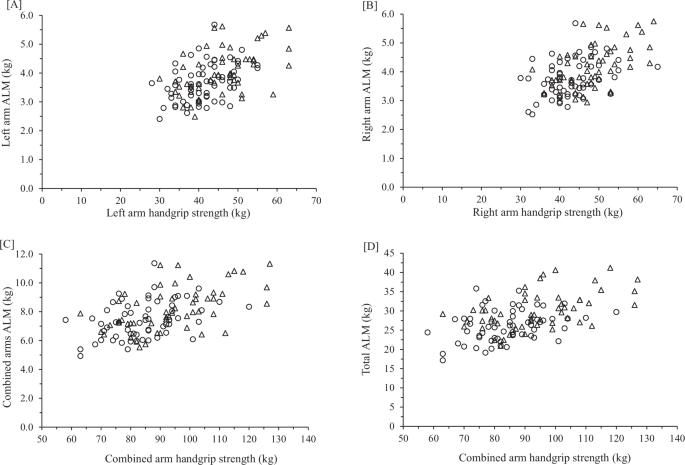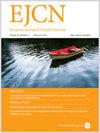Muscle quality index comparisons between Hispanics and non-Hispanic Caucasians using dual energy X-ray absorptiometry and handgrip strength
IF 3.6
3区 医学
Q2 NUTRITION & DIETETICS
引用次数: 0
Abstract
Muscle quality index (MQI) can be computed in various ways. Also, many studies have evaluated MQI in older adults and non-Hispanic populations. The aim of this study was to compare various muscle quality indexes between Hispanics and non-Hispanic Caucasians when stratifying grip strength and appendicular lean mass measurements. 235 participants (aged 25.5 ± 9.5 for males and 26.4 ± 9.9 for females) completed a dual energy X-ray absorptiometry (DXA) scan to assess appendicular lean mass (ALM). Handgrip strength (HGS) was assessed using a handheld dynamometer. MQI was computed using four different models: 1). MQIRA: ALM and HGS of right arm and hand, respectively; 2). MQILA: ALM and HGS of left arm and hand, respectively; 3). MQIARMS: ALM and HGS of both arms and hands, respectively; and 4). MQITOTAL: ALM of upper and lower-limbs and HGS of left and right hand. Hispanic males and females exhibited lower HGS compared to Caucasians with effect sizes ranging from trivial (d = 0.17) to moderate (d = 0.80). Females demonstrated higher MQI values compared to males for MQIARMS (d = 0.70), MQIRA (d = 0.75), and MQILA (d = 0.57). However, MQITOTAL yielded a small practical effect (d = 0.33) in favor of males (3.2 ± 0.5 kg/kg vs. 3.1 ± 0.5 kg/kg). After factoring by sex and ethnicity, Hispanic males and females, compared to non-Hispanic Caucasians males and females, showed trivial-to-small practical differences (d values ranging from 0.03 to 0.39). These results demonstrate MQI models vary across sex, particularly when utilizing models that account for upper extremity strength and ALM (i.e., MQIARMS, MQIRA, and MQILA). Lastly, to establish consistency in future research, the present study recommends using MQI models that account for ALM of upper- and lower-limbs (i.e., MQITOTAL). However, research measuring muscular strength via one upper-limb (e.g., left hand) might consider measuring ALM of the corresponding arm (e.g., left arm) when computing muscle quality (e.g., MQILA).


利用双能 X 射线吸收测定法和手握力量比较西班牙裔和非西班牙裔白种人的肌肉质量指数。
背景与目的:肌肉质量指数(MQI)有多种计算方法。此外,许多研究都对老年人和非西班牙裔人群的肌肉质量指数进行了评估。方法:235 名参与者(男性年龄为 25.5±9.5 岁,女性年龄为 26.4±9.9 岁)完成了双能 X 射线吸收仪(DXA)扫描,以评估阑尾瘦体重(ALM)。手握强度(HGS)使用手持式测力计进行评估。使用四种不同的模型计算 MQI:1).MQIRA:分别为右臂和手部的 ALM 和 HGS;2).MQILA:分别为右臂和手部的 ALM 和 HGS。MQILA:分别为左臂和手的 ALM 和 HGS;3).MQIARMS:分别为双臂和双手的 ALM 和 HGS;以及 4).MQITOTAL:上下肢的ALM和左右手的HGS:结果:与白种人相比,西班牙裔男性和女性的 HGS 较低,影响大小从微小(d = 0.17)到中等(d = 0.80)不等。在 MQIARMS(d = 0.70)、MQIRA(d = 0.75)和 MQILA(d = 0.57)方面,女性的 MQI 值高于男性。然而,MQITOTAL 的实际效果较小(d = 0.33),有利于男性(3.2 ± 0.5 kg/kg vs. 3.1 ± 0.5 kg/kg)。根据性别和种族进行因子分析后,西班牙裔男性和女性与非西班牙裔高加索男性和女性相比,显示出微不足道到很小的实际差异(d 值从 0.03 到 0.39 不等):这些结果表明不同性别的 MQI 模型存在差异,尤其是在使用考虑上肢力量和 ALM 的模型(即 MQIARMS、MQIRA 和 MQILA)时。最后,为了在未来的研究中建立一致性,本研究建议使用考虑上下肢 ALM 的 MQI 模型(即 MQITOTAL)。不过,通过单个上肢(如左手)测量肌肉力量的研究在计算肌肉质量(如 MQILA)时可考虑测量相应手臂(如左臂)的 ALM。
本文章由计算机程序翻译,如有差异,请以英文原文为准。
求助全文
约1分钟内获得全文
求助全文
来源期刊
CiteScore
10.60
自引率
2.10%
发文量
189
审稿时长
3-6 weeks
期刊介绍:
The European Journal of Clinical Nutrition (EJCN) is an international, peer-reviewed journal covering all aspects of human and clinical nutrition. The journal welcomes original research, reviews, case reports and brief communications based on clinical, metabolic and epidemiological studies that describe methodologies, mechanisms, associations and benefits of nutritional interventions for clinical disease and health promotion.
Topics of interest include but are not limited to:
Nutrition and Health (including climate and ecological aspects)
Metabolism & Metabolomics
Genomics and personalized strategies in nutrition
Nutrition during the early life cycle
Health issues and nutrition in the elderly
Phenotyping in clinical nutrition
Nutrition in acute and chronic diseases
The double burden of ''malnutrition'': Under-nutrition and Obesity
Prevention of Non Communicable Diseases (NCD)

 求助内容:
求助内容: 应助结果提醒方式:
应助结果提醒方式:


